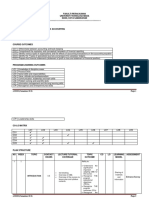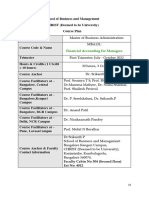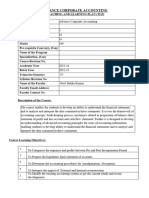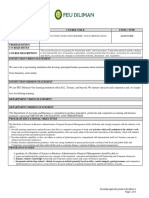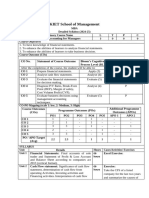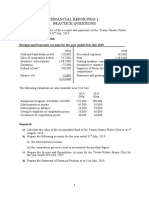FAR110 - OBE Lesson Plan - Oct2022
FAR110 - OBE Lesson Plan - Oct2022
Uploaded by
Siti Nurul AtiqahCopyright:
Available Formats
FAR110 - OBE Lesson Plan - Oct2022
FAR110 - OBE Lesson Plan - Oct2022
Uploaded by
Siti Nurul AtiqahOriginal Title
Copyright
Available Formats
Share this document
Did you find this document useful?
Is this content inappropriate?
Copyright:
Available Formats
FAR110 - OBE Lesson Plan - Oct2022
FAR110 - OBE Lesson Plan - Oct2022
Uploaded by
Siti Nurul AtiqahCopyright:
Available Formats
New format for OBE-SCL Lesson Plan Okt2022 – Feb2023
FAKULTI PERAKAUNAN
UNIVERSITI TEKNOLOGI MARA
40450, SHAH ALAM
PROGRAM NAME : DIPLOMA IN ACCOUNTANCY
PROGRAM CODE : AC110
COURSE NAME : FINANCIAL ACCOUNTING 1
COURSE CODE : FAR110
LECTURE : 2 hours/week
TUTORIAL : 1 hour/week
LECTURER :
COURSE OUTCOMES
CLO1 Describe the terms and the activities associated with financial accounting. (C2)
CLO2 Prepare accounting records and the financial statements of a sole-proprietorship business. (C3)
CLO3 Demonstrate entrepreneurial skills in task related to financial accounting simulation package for a sole-proprietorship
business. (A3)
PROGRAM OUTCOMES
PO1 Apply accounting knowledge and understanding in relevant
organisations.
PO2 Provide solutions using scientific skills to accounting issues and
problems.
PO3 Display practical skills in accounting tasks for relevant organisations.
PO4 Demonstrate interpersonal skills.
Lesson plan/FAR110/Semakan July2021 Page 1
New format for OBE-SCL Lesson Plan Okt2022 – Feb2023
PO5 Display communication skills.
PO6 Display digital skills.
PO7 Demonstrate numeracy skills.
PO8 Display leadership, autonomy, and responsibility.
PO9 Demonstrate personal skills.
P10 Demonstrate entrepreneurial skills.
P11 Display ethics and professionalism.
CO-PO MATRIX MQF 2.0
PO1 PO2 PO3 PO4 PO5 PO6 PO7 PO8 PO9 P10 P11
CO1
CO2
Lesson plan/FAR110/Semakan July2021 Page 2
New format for OBE-SCL Lesson Plan Okt2022 – Feb2023
CO3
PROGRAM EDUCATIONAL OBJECTIVES (PEO):
AFTER COMPLETING THIS PROGRAM, graduates would be:
PEO 1 Accounting technicians or administrators who apply accounting knowledge and
solutions in providing quality accounting services.
PEO 2 Accounting technicians or administrators who practice functional work skills in
relevant industries.
PEO 3 Accounting technicians and administrators who demonstrate good personal skills,
entrepreneurial skills with ethics and professionalism.
Lesson plan/FAR110/Semakan July2021 Page 3
New format for OBE-SCL Lesson Plan Okt2022 – Feb2023
CO-PEO MATRIX
PEO1 PEO2 PEO3
CO1
CO2
CO3
PLAN STRUCTURE
Contact Learning
Chapter Week Topic Lecture/ Tutorial coverage Topic Outcome CO PO Assessment
Hours Model
▪ Understand the
significance and
importance of adopting
OBE for the course.
Introduction
on OBE-SCL,
Ice breaking. ▪ Recognize FACT
Entrance ▪ Overview of OBE. program educational
Sharing of ▪ Entrance
objectives (PEOs).
1 1 survey, ½ (1L) ▪ Overview of the course via materials and Survey
Assessment lesson plan and syllabus ▪ Recognize FACT information
contents. program outcomes
plan and SLT (POs).
▪ Recognize the course
outcomes (COs).
▪ Recognize the course
topic outcomes (TOs).
1 1 Introduction to 3(3L) 1.1 Definition of accounting. Ability to: CLO1 PLO1 ▪ Sharing of ▪ Test
Accounting 1.2 Three basic activities: ▪ Define accounting. notes and ▪ Final Exam
1.2.1 Identification information
1.2.2 Recording ▪ Explain the three ▪ Lecture
1.2.3 Communication activities of accounting-
▪ Self-created
1.3 Objective of financial Identification, Recording
accounting
reporting. and Communication.
simulation
1.4 Users and uses of accounting
Lesson plan/FAR110/Semakan July2021 Page 4
New format for OBE-SCL Lesson Plan Okt2022 – Feb2023
Information: ▪ Explain the main
1.4.1 Internal users objective of financial
1.4.2 External users reporting.
1.5 Qualitative characteristic of
accounting information: ▪ Identify main user
1.5.1 Relevance groups of financial
1.5.2 Faithful representation statements – Internal
1.5.3 Comparability and external users
1.5.4 Verifiability (investors and lenders).
1.5.5 Timeliness ▪ Understand and explain
1.5.6 Understandability the qualitative
characteristics of the
accounting information.
1 2 Introduction to 3(2L/1T) 1.6 The Building Blocks of Ability to: CLO1 PLO1 ▪ Sharing of ▪ Test
Accounting Accounting: ▪ Explain the ethics in notes and ▪ Final Exam
1.6.1 Ethics in financial Financial Reporting. information
reporting. ▪ Lecture
1.6.2 Generally accepted ▪ Explain the importance ▪ Self-created
accounting principles and of GAAP and MFRS.
accounting
accounting standard. ▪ Explain the simulation
1.6.3 Measurement Principles: Measurement Principles
-Historical cost principle ▪ Explain and understand
-Objectivity principle the Assumptions,
-Full disclosure principle Concepts and
-Revenues and Conventions and able to
expenses recognition apply in answering the
principle short cases questions.
1.6.4 Accounting concepts,
conventions and
▪ Justify the need of
having GAAP and
assumptions:
MFRS.
-Monetary unit assumption
- Economic entity concept ▪ Understand the types of
- Going concern concept business entity.
-Accrual-based ▪ Differentiate the four
accounting types of business entity.
-Neutrality
-Materiality
-Consistency
1.7 Business Entity:
1.7.1 Proprietorship
1.7.2 Partnership
Lesson plan/FAR110/Semakan July2021 Page 5
New format for OBE-SCL Lesson Plan Okt2022 – Feb2023
1.7.3 Limited liability
partnership
1.7.4 Company
2 3 Accounting 3(2L/1T) 2.1 Accounting cycle: Ability to: CLO1 PLO1 ▪ Sharing of ▪ Test
Cycle and 2.1.1 Source documents ▪ Understand the notes and ▪ Final Exam
Accounting Journal accounting cycle from information
Ledger (Three column) source documents to ▪ Lecture
Equation
Trial balance the preparation of ▪ Tutorial –
Adjustments financial statements. past year
Financial statements ▪ Understand and Q&A
2.2 Accounting equation: explain the term
2.2.1 Basic accounting assets, liabilities and
equation. owner’s equity.
2.2.2 Expanded accounting ▪ Understand the basic
equation. accounting equation.
2.2.3 Elements of accounting ▪ Understand the
equation: expanded accounting
-Asset equation.
-Liability ▪ Show the effects of
-Owner’s equity transactions on
-Revenue and expense accounting equation.
▪ Understand credit
terms
▪ Understand the
importance of each of
the financial
statements.
3 4 Double Entry 3(2L/1T) 3.1 Double entry principle: Ability to: CLO1 PLO1 ▪ Sharing of ▪ Test
System 3.1.1 Double entry rule for asset. ▪ Understand the debit notes and
3.1.2 Double entry rule for and credit procedure. information
liability. ▪ Identify the correct ▪ Lecture
3.1.3 Double entry rule for classification of ▪ Tutorial –
capital. accounts for Assets, past year
3.1.4 Double entry rule for Liabilities, Q&A
drawing Owner’s Equity,
3.1.5 Double entry rule for Drawings Revenue
revenue. and Expenses.
3.1.6 Double entry rule for ▪ Understand the
expense. summary of Dr/Cr
3.2 The relationship between rules.
Lesson plan/FAR110/Semakan July2021 Page 6
New format for OBE-SCL Lesson Plan Okt2022 – Feb2023
accounting equation and double ▪ Understand how to
entry rule: analyse transactions
3.2.1 Transaction analysis. on the accounting
equation (Format
Transaction Analysis).
▪ Understand how to
draw up the standard
form of three column
general ledger.
4 5 Journal, 3(2L/1T) 4.1 Journal: Ability to: CLO1 PLO1 ▪ Sharing of ▪ Test
Ledger and 4.1.1 General journal. ▪ Understand the CLO2 PLO2 notes and ▪ Final
Trial Balance 4.1.2 Specialised journal: importance of each of CLO3 PLO10 information exams
-Sales journal the source documents. ▪ Lecture ▪ Group
-Sales return journal ▪ Understand the ▪ Tutorial – Project -
-Purchase journal purpose of each of the past year Accounting
-Purchase return journal specialised journal. Q&A Simulation
-Cash receipts journal ▪ Prepare the
-Cash payments journal specialised journal
from the source
documents.
4 6 Journal, 3(2L/1T) - Petty cash journal ▪ Understand the CLO2 PLO2 ▪ Sharing of ▪ Final
Ledger and importance of notes and exams
Trial Balance managing petty cash. information
▪ Prepare the ▪ Lecture
reimbursement of ▪ Tutorial –
petty cash/ imprest past year
petty cash system Q&A
4 7 Journal, 3(2L/1T) 4.2 Ledger: Ability to: CLO1 PLO1 ▪ Sharing of ▪ Test
Ledger and 4.2.1 Sales ledger. ▪ Posting from the CLO3 PLO10 notes and ▪ Group
Trial Balance 4.2.2 Purchase ledger. specialised journal to information Project -
4.2.3 General ledger. three-column general ▪ Lecture Accounting
4.3 Trial Balance: ledger. ▪ Tutorial – Simulation
4.3.1 Trial balance format. ▪ Understand the past year
4.3.2 Purpose of a trial balance purpose of preparing Q&A
(introduction of SOPL and the Trial Balance.
SOFP format) ▪ Understand the
limitation of Trial
Balance.
▪ Prepare the Trial
Balance.
Lesson plan/FAR110/Semakan July2021 Page 7
New format for OBE-SCL Lesson Plan Okt2022 – Feb2023
▪ Prepare the SOPL
and SOFP (without
adjustment)
5 8 Accounting 3(2L/1T) 5.1 Error versus fraud. Ability to: CLO1 PLO1 ▪ Sharing of ▪ Test
Errors 5.2 Types of accounting errors: ▪ Locate the errors. notes and ▪ Final exams
5.2.1 Errors that affect the trial ▪ Identify the errors. information
balance. ▪ Understand how to ▪ Lecture
5.2.2 Errors not affecting the trial make correction ▪ Discussion
balance. of errors affecting the ▪ Tutorial –
5.3 Correcting the errors. trial balance. past year
5.3.1 Correction of errors ▪ Understand how to Q&A
affecting trial balance. make corrections of
5.3.2 Correction of errors not errors not affecting the
affecting trial balance. trial balance.
▪ Define the suspense
account
5 9 Accounting 3(2L/1T) 5.4 The suspense account ▪ Explain the use of CL02 PLO2 ▪ Sharing of ▪ Final exam
Errors suspense accounts. notes and
▪ Draw up a suspense information
account ▪ Lecture
▪ Calculate the revised ▪ Discussion
profit ▪ Tutorial –
past year
Q&A
6 10 Accounting 3(3L) 6.1 Accruals and prepayments Ability to: CL02 PLO2 ▪ Sharing of ▪ Final exam
Adjustments 6.2 The implications on the financial ▪ Understand the notes and
statement timing issues information
6.3 The recording in the financial which lead to ▪ Lecture
statement Accrual Basis ▪ Discussion
6.4 The causes of depreciation. Accounting. ▪ Tutorial –
6.5 Recording and reporting of ▪ Understand the past year
depreciation expense and non- concept of Q&A
current assets. accruals and
6.6 Methods of depreciation: prepayments.
7.4.1 Straight line method. ▪ Prepare the
7.4.2 Reducing balance method. journal entries to
6.7 Factors to consider in record the
depreciation calculation. adjustments.
Lesson plan/FAR110/Semakan July2021 Page 8
New format for OBE-SCL Lesson Plan Okt2022 – Feb2023
▪ Posting the
adjusting entries
to the three
column general
ledger
▪ Understand the
term and causes
of depreciation.
▪ Students are
required to
calculate the
amount of
depreciation for
the current year
only.
▪ Transfer the
amount of
depreciation from
journal to ledger.
6 11 Completing 3(2L/1T) 6.8 Preparing the adjusted trial Ability to: CL02 PLO2 ▪ Sharing of ▪ Final exam
the balance. ▪ Prepare closing notes and
Accounting 6.9 Preparing the adjusted financial entries. information
Cycle and statements ▪ Posting closing entries ▪ Lecture
Financial to three column ledger. ▪ Discussion
Statements ▪ Prepare a post-closing ▪ Tutorial –
trial balance. past year
Q&A
7 12 Accounting 3(2L/1T) 7.1 Purpose and the explanation of Ability to: CL01 PLO1 ▪ Sharing of ▪ Final exam
Ratio accounting ratio ▪ Explain the importance notes and
7.2 Types of ratio: of accounting ratio. information
7.2.1 Profitability ratio ▪ Lecture
7.2.2 Gross profit ratio ▪ Describe the different ▪ Discussion
types of accounting
7.2.3 Net profit ratio ▪ Tutorial –
7.2.4 Liquidity ratio ratio.
past year
7.2.5 Current ratio ▪ Calculate and interpret Q&A
7.2.6 Acid test ratio the main types of
7.2.7 Efficiency ratio accounting ratio.
7.2.8 Inventory turnover ratio ▪ Discuss the use of
7.3 Usefulness of accounting ratios ratios in analysing the
7.4 Limitations of accounting ratios performance, liquidity,
Lesson plan/FAR110/Semakan July2021 Page 9
New format for OBE-SCL Lesson Plan Okt2022 – Feb2023
efficiency and
leverage of the
business.
▪ State the usefulness
and limitations of
ratios.
8 13 Bank 3(2L/1T) 8.1 Cash and bank transactions. Ability to: CLO1 PLO1 ▪ Sharing of ▪ Final exam
Reconciliation 8.2 Bank statement. ▪ Know who is notes and
8.3 Bank reconciliation and its responsible for making information
purpose. bank deposits. ▪ Lecture
8.4 Transactions recorded by the ▪ Know the element in a ▪ Discussion
business but not by the bank. cheque. ▪ Tutorial –
8.5 Transactions recorded by the ▪ Understand that using past year
bank but not by the business. a cheque is a method Q&A
8.6 Error. of cash control.
8.7 The bank reconciliation ▪ Understand the
techniques: importance and
9.7.1 Steps in preparing a bank purpose of a bank
reconciliation. statement.
▪ Understand the
reasons why the
balance in bank
statements and
business bank
accounts is different.
▪ Reconcile the bank
statement with the
business bank account
(three column ledger)
or CRJ and CPJ.
▪ Prepare the Bank
Reconciliation
Statement.
9 14 Incomplete 3(2L/1T) 9.1 Single entry and double entry Ability to: CLO2 PLO2 ▪ Sharing of Group Project
Records system. ▪ Differentiate between a notes and 2 - PBL
9.2 Disadvantages of a single entry single entry system and information
system: a double entry system. ▪ Lecture
9.2.1 Unsystematic system. ▪ Distinguish between ▪ Discussion
9.2.2 Incomplete system. Comparison and
9.2.3 Lack of accuracy. Analysis Method.
Lesson plan/FAR110/Semakan July2021 Page 10
New format for OBE-SCL Lesson Plan Okt2022 – Feb2023
9.2.4 Does not reflect true profit ▪ Prepare a Statement of ▪ Tutorial –
or loss. Affairs (beginning and past year
9.2.5 Does not reflect true end of the year). Q&A
financial affairs. ▪ Reconstruct of
9.2.6 Frauds and errors. accounting records
9.2.7 Unacceptable for tax (three column ledger).
purpose. ▪ Prepare the Statement of
9.3 Comparison and analysis Profit or Loss.
methods: ▪ Prepare the Statement of
9.3.1 Comparison method. Financial Position.
9.3.2 Analysis method.
9.4 Preparation of the statement of
profit or loss and statement of
financial position.
Continuous Assessment:
Topics Marks
Test Chapter 1: Introduction to Accounting 15%
Chapter 2: Accounting cycle and equation
Chapter 3: Double Entry System
Chapter 4: Journal, Ledger and Trial Balance
Group Assignment Chapter 10: Incomplete Records - Problem Based Learning 10%
Self-Created Accounting Simulation 15%
Total 40%
Lesson plan/FAR110/Semakan July2021 Page 11
You might also like
- AC4052NI Financial AccountingDocument3 pagesAC4052NI Financial AccountingBigendra ShresthaNo ratings yet
- Two Approaches in Determining IncomeDocument14 pagesTwo Approaches in Determining IncomeAnDrea ChavEzNo ratings yet
- Case-Competition (Good Over View On Private Equity Deal Process) PDFDocument35 pagesCase-Competition (Good Over View On Private Equity Deal Process) PDFSubhronil BoseNo ratings yet
- Chapter 30 - Financial Instruments: QUESTION 30-11 Multiple Choice (PAS 32)Document4 pagesChapter 30 - Financial Instruments: QUESTION 30-11 Multiple Choice (PAS 32)Janine Camacho100% (2)
- New Format For OBE-SCL Lesson PlanDocument20 pagesNew Format For OBE-SCL Lesson PlanNur Raihan TamrianNo ratings yet
- Tax517 Lesson PlanDocument7 pagesTax517 Lesson Plan2023415284No ratings yet
- New Format For OBE-SCL Lesson PlanDocument10 pagesNew Format For OBE-SCL Lesson PlannorshaheeraNo ratings yet
- Lesson Plan ACC030Document6 pagesLesson Plan ACC030Fatin AkmalNo ratings yet
- OBELESSON PLAN- STUDENTS' COPYDocument14 pagesOBELESSON PLAN- STUDENTS' COPYrumaisyaNo ratings yet
- FAR110 - OBE Lesson Plan - Semakan Sept 2017-JHADocument13 pagesFAR110 - OBE Lesson Plan - Semakan Sept 2017-JHAyokyNo ratings yet
- Acc407 - Lesson PlanDocument7 pagesAcc407 - Lesson PlanSibernet CFNo ratings yet
- Leading University Department of Business Administration: Course ProfileDocument4 pagesLeading University Department of Business Administration: Course ProfileDipika tasfannum salamNo ratings yet
- MAF661 OBELessonPlan October 2020 - February 2021Document9 pagesMAF661 OBELessonPlan October 2020 - February 2021Nur Dina AbsbNo ratings yet
- Fakulti Perakaunan Universiti Teknologi Mara:: Norasmila Awang: Asmila725@uitm - Edu.my .: 04 4562562: A2 3040Document5 pagesFakulti Perakaunan Universiti Teknologi Mara:: Norasmila Awang: Asmila725@uitm - Edu.my .: 04 4562562: A2 3040Nur슈하다No ratings yet
- TAX267 - OBE Lesson Plan Oct2023 - Feb2024Document11 pagesTAX267 - OBE Lesson Plan Oct2023 - Feb2024NUR ATHIRAH ZAINONNo ratings yet
- OBE-SCL Lesson PlanDocument10 pagesOBE-SCL Lesson PlanMuhammad HamiziNo ratings yet
- Advanced Financial Accounting and Reporting 2 (FAR 660) - Lesson Plan 2017Document12 pagesAdvanced Financial Accounting and Reporting 2 (FAR 660) - Lesson Plan 2017cikita6750% (2)
- FAM 2022 - Course Plan - V4Document12 pagesFAM 2022 - Course Plan - V4bharath.bkNo ratings yet
- Session Plan Sample 2Document20 pagesSession Plan Sample 2Beliver BeliverNo ratings yet
- Programme: MBA: Teaching - Learning PlanDocument8 pagesProgramme: MBA: Teaching - Learning PlanHarsh KandeleNo ratings yet
- Accounting Outline 1Document4 pagesAccounting Outline 1MUHAMMAD ZULHAIRI BIN ROSLI STUDENTNo ratings yet
- Financial Accounting & Analysis - Session Plan - Batch 2024-26 - Sem-IDocument4 pagesFinancial Accounting & Analysis - Session Plan - Batch 2024-26 - Sem-IvikastgpNo ratings yet
- Accounting For Partnership and Corporation: Course Code Course Title Units / TypeDocument8 pagesAccounting For Partnership and Corporation: Course Code Course Title Units / TypeAyie Rose HernandezNo ratings yet
- Principles of Accounting I (34101) Asma Znaimat 2024 2025-3Document9 pagesPrinciples of Accounting I (34101) Asma Znaimat 2024 2025-3lilianjammal2005No ratings yet
- AF102 Course OutlineDocument12 pagesAF102 Course OutlineStayNo ratings yet
- Far410 New Format Obe Lesson PlanDocument9 pagesFar410 New Format Obe Lesson PlanLya MaclindaNo ratings yet
- Lesson PlanDocument12 pagesLesson PlanIeymarh FatimahNo ratings yet
- 614 Course Name: Financial AccountingDocument10 pages614 Course Name: Financial AccountingShiv Shankar ShuklaNo ratings yet
- Course Outline ACN 301 SP'24Document16 pagesCourse Outline ACN 301 SP'24Simantha BaruaNo ratings yet
- FR Outline - Graduate School Upsa 2020Document10 pagesFR Outline - Graduate School Upsa 2020biggykhairNo ratings yet
- (MBA ACC Major OBE CO) Financial Statement AnalysisDocument7 pages(MBA ACC Major OBE CO) Financial Statement AnalysisMahfuz Ur RahmanNo ratings yet
- Acc516 Lesson Plan - Obe Sept 2016Document6 pagesAcc516 Lesson Plan - Obe Sept 2016jihahNo ratings yet
- Fundamentals of AccountingDocument8 pagesFundamentals of Accountingneelmehta945No ratings yet
- Conceptual Framework and Accounting Standard SyllabusDocument12 pagesConceptual Framework and Accounting Standard Syllabusrenzelmagbitang222No ratings yet
- (MBA ACC Major OBE CO) Corporate Tax ManagementDocument5 pages(MBA ACC Major OBE CO) Corporate Tax ManagementMahfuz Ur RahmanNo ratings yet
- ACN 201 Course Outline Spring 2023Document7 pagesACN 201 Course Outline Spring 2023Namira Rahman BarishaNo ratings yet
- Acc C606Document9 pagesAcc C606Gailee VinNo ratings yet
- MAF661 OBELessonPlan 20224 Semester Mac-Aug 2023Document10 pagesMAF661 OBELessonPlan 20224 Semester Mac-Aug 2023Lyana InaniNo ratings yet
- ACCT 1026 Financial Accounting and Reporting 2019Document11 pagesACCT 1026 Financial Accounting and Reporting 2019Kath DayagNo ratings yet
- Teaching Plan - ATW153_Financial Accounting_Sem1_2024_2025_121023_vFINALDocument10 pagesTeaching Plan - ATW153_Financial Accounting_Sem1_2024_2025_121023_vFINALizzatihisham05No ratings yet
- Lesson Plan Maf551 - 11 Oktober 2021Document11 pagesLesson Plan Maf551 - 11 Oktober 2021Nur Dina AbsbNo ratings yet
- L1 M4 Curriculum Analysis Modified 1Document27 pagesL1 M4 Curriculum Analysis Modified 1Ratnakar NutenkiNo ratings yet
- Accounting SyllabusDocument3 pagesAccounting Syllabussg8055827No ratings yet
- Financial Accounting PracticesDocument6 pagesFinancial Accounting PracticesdimazNo ratings yet
- Updated AC 43 Syllabus Financial MathematicsDocument11 pagesUpdated AC 43 Syllabus Financial MathematicsgwynethlovelypuebloNo ratings yet
- ACCT 1046 - Intermediate Accounting 1Document10 pagesACCT 1046 - Intermediate Accounting 1Rhianne ManicapNo ratings yet
- 10-Audit Reporting BSAFDocument5 pages10-Audit Reporting BSAFRashmean RizwanNo ratings yet
- BAC2684 Financial Statement Analysis - SyllabusDocument15 pagesBAC2684 Financial Statement Analysis - SyllabuspremsuwaatiiNo ratings yet
- Table 3: Summary of Information On Each Course Design Development StageDocument15 pagesTable 3: Summary of Information On Each Course Design Development StageSani Oghang PekanNo ratings yet
- TOS Accounting 8D 4th ExamDocument3 pagesTOS Accounting 8D 4th ExamKathleenNo ratings yet
- BACC116 Financial Accounting 1 - S2 2015Document8 pagesBACC116 Financial Accounting 1 - S2 2015Melody AhNo ratings yet
- BC 103. Taxation IncomeDocument8 pagesBC 103. Taxation Incomezekekomatsu0No ratings yet
- Outline ACC1023Document7 pagesOutline ACC1023nadiah noordinNo ratings yet
- Applied Portfolio Management Ms UcpDocument4 pagesApplied Portfolio Management Ms UcpSheraz HassanNo ratings yet
- Cir Pac1163Document4 pagesCir Pac1163NUR AISYAH BINTINISWADI (BG)No ratings yet
- Bba 1 SemmoduleDocument33 pagesBba 1 Semmoduleinf12309No ratings yet
- PPT's - C - R - Muthukrishnan - NBA-AWARENESS - WEBINAR-Outcomes-Assessments-Continuous ImprovementDocument82 pagesPPT's - C - R - Muthukrishnan - NBA-AWARENESS - WEBINAR-Outcomes-Assessments-Continuous ImprovementbhaveshNo ratings yet
- 1.1 Syllabus - ACC C203 BSA-1Document7 pages1.1 Syllabus - ACC C203 BSA-1Jessica TalionNo ratings yet
- KBUS305 Syllabus FranklinE1Document17 pagesKBUS305 Syllabus FranklinE1TSERING LAMANo ratings yet
- AUD339 - OBE Lesson Plan 1Document11 pagesAUD339 - OBE Lesson Plan 1MUHAMMAD AMIR HAMZAH NURZAFILNo ratings yet
- 2020 FMGT 1013 - Financial Management RevisedDocument9 pages2020 FMGT 1013 - Financial Management RevisedYANIII12345No ratings yet
- Certified PM² Practitioner by PM² GROUP CoursewareFrom EverandCertified PM² Practitioner by PM² GROUP CoursewareNo ratings yet
- Problem Exercises - TaxationDocument2 pagesProblem Exercises - TaxationDanny LabordoNo ratings yet
- S2021 Financial Accounting and Reporting UK GAAPDocument10 pagesS2021 Financial Accounting and Reporting UK GAAPChoo LeeNo ratings yet
- 299 342 PDFDocument44 pages299 342 PDFmahmoud_hawk100% (1)
- Ex 3.12Document4 pagesEx 3.12Waritsa KupraditNo ratings yet
- Golden Bell Challenge: Acca F6 Taxation - June 2019Document215 pagesGolden Bell Challenge: Acca F6 Taxation - June 2019Phương NguyễnNo ratings yet
- Snapshot - IFRS 9 - Financial Instruments - Hedge AccountingDocument1 pageSnapshot - IFRS 9 - Financial Instruments - Hedge AccountingottieNo ratings yet
- DPL Annual Report 2022 23 PagesDocument1 pageDPL Annual Report 2022 23 Pagesworkf17hoursformeNo ratings yet
- Financial Statements Answers FFFFFFFFFFF PDFDocument27 pagesFinancial Statements Answers FFFFFFFFFFF PDFJHEYNo ratings yet
- Accounts MCQDocument95 pagesAccounts MCQAdwait BowlekarNo ratings yet
- Allocation of Dividends DIscussion and ProblemDocument2 pagesAllocation of Dividends DIscussion and Problemhm92q9fjfyNo ratings yet
- Practice Questions-Accounts For Mon Profit Making-1Document4 pagesPractice Questions-Accounts For Mon Profit Making-1Letsah Bright100% (1)
- Unit Iii: Cost of CapitalDocument109 pagesUnit Iii: Cost of CapitalMehak SinghNo ratings yet
- International Accounting Standards: IAS 40 Investment PropertyDocument22 pagesInternational Accounting Standards: IAS 40 Investment PropertyPrudence MagaragadaNo ratings yet
- Oracle Fusion Assets Predefined ReportsDocument5 pagesOracle Fusion Assets Predefined Reportsعبدالرحمن فؤادNo ratings yet
- Struktur TelkomDocument2 pagesStruktur TelkomRisky FajarNo ratings yet
- Ilovepdf MergedDocument257 pagesIlovepdf MergedSubhahan BashaNo ratings yet
- Ch11: Leverage and Capital Structure: Table 11.1, P. 422Document2 pagesCh11: Leverage and Capital Structure: Table 11.1, P. 422Chelsea WulanNo ratings yet
- Fundamentals of Financial Management PDFDocument187 pagesFundamentals of Financial Management PDFSukanya Som100% (1)
- Advacc - Intercompany PDFDocument143 pagesAdvacc - Intercompany PDFGelyn CruzNo ratings yet
- Procedures of Forming A Company in TanzaDocument20 pagesProcedures of Forming A Company in TanzaMercy MzingaNo ratings yet
- Dividend Payment AnalysisDocument17 pagesDividend Payment Analysisapi-690972820No ratings yet
- 5 Cs of Credit - Caskey Trucking FinancialsDocument5 pages5 Cs of Credit - Caskey Trucking FinancialsHazem ElsherifNo ratings yet
- Test Series: October, 2018 Mock Test Paper - 2 Intermediate (New) : Group - Ii Paper - 5: Advanced AccountingDocument7 pagesTest Series: October, 2018 Mock Test Paper - 2 Intermediate (New) : Group - Ii Paper - 5: Advanced Accountingsahil kumarNo ratings yet
- Case 1:: Industrial Industrial Capitalist CapitalistDocument3 pagesCase 1:: Industrial Industrial Capitalist CapitalistAnonnNo ratings yet
- Alternative Investments - PPT 1Document53 pagesAlternative Investments - PPT 1Mahesh VommiNo ratings yet
- Topic Overview 9 - Financial StatementsDocument12 pagesTopic Overview 9 - Financial StatementsPohon TeduhNo ratings yet
- Enron Message BoardDocument36 pagesEnron Message Boardrwmortell3580No ratings yet







